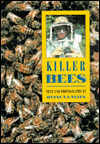|
Click on the book to read
Amazon reviews
|
Killer bees. Sounds scary. Do you wonder why there are bees that are called “killer bees”? The story starts way back millions of years ago in the land that we now call Asia when bees first appeared on earth. Some bees migrated to Europe and others to Africa. The environments in Europe and Africa were quite different, so the bees adapted in ways to help them survive. In the cooler winters in Europe, the bees set up their nests on the hollow of trees or other high, sheltered places. It was not so easy for predators to come to such well protected nests. Their nests were seldom attacked, so the European bees didn’t develop aggressive stinging behaviors. But in the hot climate in Africa, it was easier for their enemies to attack their colonies. These African bees had their nests in open spaces like roofs and also in holes in the ground. In order to defend themselves, they became very aggressive, stinging their predators fiercely. The European bees produced less honey than the more aggressive African bees. In the 1950’s, beekeepers in Brazil wanted their European bees to make more honey. There was an experiment with the European bees and the African bees. The new bees from this experiment were as aggressive as the African bees. They were supposed to be confined in their hives, but they escaped and have spread to many parts of the Americas. It is estimated that there are more than one trillion of these Africanized bees in the Americas. As you can imagine, people can get into real trouble if they accidentally disturb a killer bee nest since these bees will defend their hive with great force. Large numbers of killer bees, sometimes hundreds of them, can chase and surround their enemies to sting them. Since 1957 they have killed hundreds of people in Brazil and in the Americas. Discover more bee facts and find out how people have learned to live with killer bees and what they can do to protect themselves. (May Harn Liu, may@mailbox.sc.edu, librarian)
|

